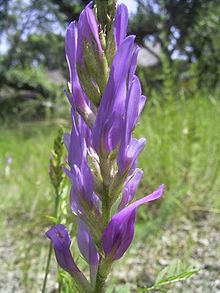Esparsette tragacanth
| Esparsette tragacanth | ||||||||||||
|---|---|---|---|---|---|---|---|---|---|---|---|---|

Esparsette tragacanth ( Astragalus onobrychis ) |
||||||||||||
| Systematics | ||||||||||||
|
||||||||||||
| Scientific name | ||||||||||||
| Astragalus onobrychis | ||||||||||||
| L. |
The Esparsette tragacanth ( Astragalus onobrychis ), also flag tragacanth or long-flag tragacanth , is a species of the legume family (Fabaceae). The specific epithet refers to the Greek word Onóbrychis for Saat-Esparsette because of the similarity of the bright purple flowers.
features
The Esparsette tragacanth is a perennial , creeping plant and is 10 to 30, rarely up to 60 cm long. It does not form a rosette. The stem is leafy and prostrate to ascending. Compass needle hairs sit on the stems and leaves. The stipules are almost completely fused together.
It has a taproot and is a hemicryptophyte . He's a deep rooter.
The inflorescence is a spike with 10 to 30 flowers . It is heady at first and later becomes longer. The crown is bright purple to purple-purple in color and 18 to 24 mm long. The flag almost linear and 6 to 10 mm longer than the wings.
Ovary and later the fruit are sessile, slightly puffy and hairy white. Flowering time in Austria is June to July, rarely until September.
The number of chromosomes is 2n = 64 or 72.
Distribution and locations
Esparsette tragacanth is native to Europe and West Asia and has a submeridional-subtemperate distribution. The continentality is given as c3-8 (on a scale up to 10).
In Germany, the Esparsette tragacanth was a neophyte , occurred in central and north-west Bavaria, but has since died out.
In Austria, the Esparsette tragacanth occurs in Burgenland, Vienna, Lower Austria, Southwest Carinthia and North Tyrol (especially in the Upper Inn Valley), in Upper Austria and Styria only inconsistently, in East Tyrol it is extinct. In the Pannonian area it is common to dispersed, in the rest of the country it is rare. In South Tyrol it is often to scattered in the Etsch and Eisack valleys.
In Central Europe it is a characteristic of the Festucetalia valesiacae.
supporting documents
- ↑ a b c d Werner Rothmaler: Excursion flora from Germany. Volume 4. Vascular Plants: Critical Volume . 10th edition, Elsevier, Munich 2005, ISBN 3-8274-1496-2 , p. 451.
- ↑ a b c d e Manfred A. Fischer , Karl Oswald, Wolfgang Adler: Excursions flora for Austria, Liechtenstein and South Tyrol. 3rd, improved edition. Province of Upper Austria, Biology Center of the Upper Austrian State Museums, Linz 2008, ISBN 978-3-85474-187-9 , p. 586f.
- ↑ Helmut Genaust: Etymological dictionary of botanical plant names. Birkhäuser, Basel / Stuttgart 1976, 3rd edition ISBN 3-937872-16-7 .
- ↑ a b c Erich Oberdorfer : Plant-sociological excursion flora for Germany and neighboring areas . 8th edition. Verlag Eugen Ulmer, Stuttgart 2001, ISBN 3-8001-3131-5 . Page 603.
Web links
- Esparsette tragacanth. In: FloraWeb.de.
- Esparsette tragacanth . In: BiolFlor, the database of biological-ecological characteristics of the flora of Germany.
- Profile and distribution map for Bavaria . In: Botanical Information Hub of Bavaria .
- Astragalus onobrychis L. In: Info Flora , the national data and information center for Swiss flora . Retrieved November 19, 2015.
- Distribution map Euro + Med
- Thomas Meyer: Data sheet with identification key and photos at Flora-de: Flora von Deutschland (old name of the website: Flowers in Swabia )
